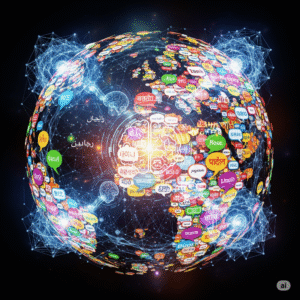Imagine you’re a detective. Your job is to find clues, figure out who needs your help, and then solve their problem. That’s what a salesperson does every day! But sometimes, the clues are buried in a mountain of emails, and it’s hard to know who is a real person to talk to and who is just looking. This is where your new sidekick, AI, comes in. These clever helpers, or AI tools for sales, are like having a super-powered magnifying glass and a crystal ball all in one, helping you find the right people and know exactly what they need.
This guide will be your training manual, showing you how to use AI to become a sales superhero. We’ll follow the story of a sales rep named Jake. He was a great talker and a hard worker, but he felt like he was always running in circles. Through his journey, you’ll discover how AI can help you stop guessing and start knowing, making your sales efforts easier and a lot more successful.
The Story of Jake: From Busy to Brilliant (AI tools for sales)
Jake was a sales rep for a company that sold smart home devices. He spent his days making calls, sending emails, and trying to remember who he spoke to and when. Also, He had a big list of potential customers, but he had no idea which ones were actually interested. He would call everyone, hoping to get lucky. This constant “spray and pray” approach was exhausting and didn’t lead to many sales. Without the right AI tools for sales, he was just making noise.
One morning, his manager introduced a new system. It had fancy AI features that promised to help them work smarter. Jake was skeptical. He thought, “A robot can’t talk to people like I can!” However, he decided to give it a shot. His journey with AI tools for sales began with a single, simple mission: find the right people to talk to.
Step 1: Using AI for Lead Scoring
Jake’s first big task was to figure out who on his list was most likely to buy something. This is a process called “lead scoring.” In the old days, he just had to guess. Now, the new AI system did it for him. It looked at all the information it could find: which emails a potential customer opened, which pages they looked at on the website, and even how long they spent on a product page.
Based on all these clues, the AI gave each person a score. A high score meant they were very interested, and a low score meant they probably weren’t ready to buy yet. This was a massive change for Jake. He went from calling 100 people and hoping for a sale to calling 10 people he knew were interested. It was like magic. This incredible use of AI for lead scoring immediately boosted his sales and saved him countless hours.
Step 2: The Power of Conversational AI
Another big problem for Jake was handling all the simple questions people asked. “What’s the price?” or “What colors does this come in?” Answering these questions took up so much of his time that he couldn’t get to the important conversations. The new system included a chatbot on the website. This was a form of conversational AI.
The chatbot would talk to visitors and answer their easy questions right away. If someone asked a more complex question or seemed very interested, the chatbot would then tell Jake, “This person is ready to talk to a human!” This freed up Jake’s time to focus on the serious buyers. It meant he was no longer a human FAQ machine; he was a problem-solver, ready to jump into action when it mattered most. This is a prime example of how conversational AI can change a sales rep’s day-to-day life.
Real-World Case Studies: Supercharging Sales with AI (AI tools for sales)
Content Strategy with AI: The New Role of the Content Strategist
Many companies are already using AI to get ahead in the sales game. Here are three examples that show how powerful these tools can be.
Case Study 1: The Small SaaS Company and AI for Sales Forecasting
A small software company called ‘AppFlow’ needed to predict how much money they would make next quarter. In the past, the sales team would just look at their current deals and make an educated guess. This often led to inaccurate predictions. They started using a new AI for sales forecasting tool. The AI would look at their past sales data, the time it took to close deals, and even external factors like the season. The AI’s prediction was so accurate that the company was able to plan their budget and hiring with much more confidence. It’s an incredible tool for making smart business decisions.
AI-Driven Adaptive Learning: The Future of Your Classroom
Case Study 2: The Real Estate Agent with a Personal AI Assistant
A real estate agent, Lisa, was spending hours every week sifting through listings and writing personalized emails to potential buyers. She started using a smart AI assistant that would look at her client’s wish lists (number of bedrooms, location, price range) and automatically find new homes that fit their criteria. It would then draft a personalized email for each client. She still had to read and approve the emails, but the AI did all the heavy lifting. This saved her so much time that she was able to serve twice as many clients, showing the power of AI tools for sales.
Case Study 3: The Retail Company and Conversational AI for Customer Service (AI tools for sales)
A large online retailer, ‘Trendify,’ had a customer service team that was overwhelmed with simple questions about returns and order tracking. They implemented a conversational AI chatbot that could answer over 80% of these simple questions instantly. This freed up their human customer service reps to handle the more complex and difficult problems. This not only made their customers happier but also allowed their sales team to focus on new leads instead of troubleshooting old orders.
Top AI Tools for Your Sales Arsenal
You don’t need to be a tech expert to use these tools. Here are a few great AI tools for sales that can help you get started.
- Salesforce Einstein: This is a big, powerful set of AI tools built right into the Salesforce platform. It can do everything from predicting which leads are most likely to convert to helping you write personalized emails.
- Drift: This is a fantastic conversational AI platform. It’s a chatbot that lives on your website and can chat with visitors, answer their questions, and even book meetings for you.
- Gong: Gong uses AI to listen to and analyze your sales calls. It can give you feedback on what you said well, what you could improve, and what topics resonated most with customers. This is an incredible tool for getting better at your job.
- Chorus.ai: Similar to Gong, Chorus uses AI to analyze conversations. It can help you understand what makes a successful sales call and what common mistakes you might be making. It’s an invaluable tool for any salesperson who wants to improve their skills.
How-To Tips: Your Actionable Playbook
The best way to start is with one small task. Here are a few simple, step-by-step workflows to help you master AI for sales forecasting and more.
Workflow 1: How to Qualify a Lead with AI
- Gather the Clues: Find all the information you can about a potential customer. This includes which pages they visited on your website, which emails they opened, and any forms they filled out.
- Ask the AI to Analyze: Use a tool that includes AI for lead scoring. Feed it all your information and let it give you a score.
- Take Action: If the score is high, you know this person is worth a phone call. If the score is low, you can put them in a different list for a follow-up email later. This helps you work smarter, not just harder.
Workflow 2: Using Conversational AI to Save Time
- Find Repetitive Questions: Look at all the simple questions people ask you over and over again. For example, “What are your hours?” or “Where can I find your prices?”
- Set Up a Chatbot: Use a conversational AI tool like Drift to create a simple chatbot.
- Teach the Bot: Teach the chatbot to answer these simple questions. You can give it a script to follow. Now, when a customer asks a simple question, the chatbot can answer it immediately, and you can focus on more important things.
A Word of Advice: AI as a Partnership (AI tools for sales)
It’s important to remember that AI is a tool, not a replacement for you. It won’t build relationships, listen to a customer’s feelings, or close a complex deal. These are all things that require the human touch. The best AI tools for sales are those that free you up from boring tasks so you can focus on what you do best: talking to people, building trust, and solving their problems. The path to a more successful and less stressful sales career is now yours to create, and it all begins with your first small step.
Credible References:
- HubSpot: How AI Is Changing the Sales Process
- McKinsey: The Future of Sales with AI



